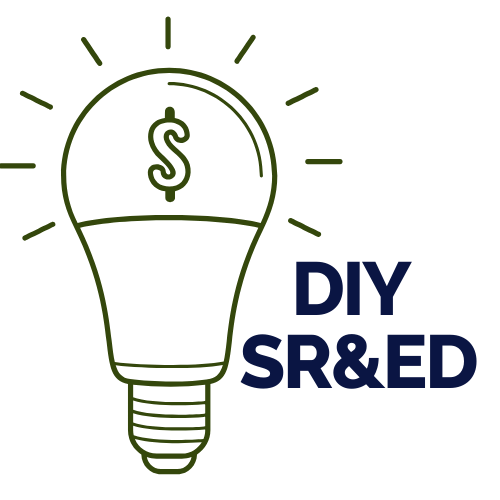Filing your first SR&ED claim and looking for a simple T661 form guide? You’re in the right place. This guide from DIY SR&ED is made for Canadian startup founders who are tackling their SR&ED claim solo — no consultants, just DIY.
What Is the T661 Form?
The T661 form is at the heart of Canada’s Scientific Research and Experimental Development (SR&ED) program. It’s how you prove to the CRA that your R&D project qualifies and how you report your eligible expenses.
The T661 form has 10 main parts:
- Part 1: General company info
- Part 2: Project details
- Parts 3 to 6: Financials, overhead, and ITC
- Parts 7 to 10: Checklists and documentation
If this is your first SR&ED claim, we’ve got you covered. Most founders find Parts 1 and 7–10 easy to complete. So this T661 form guide focuses on Parts 2 through 6 — the core of your SR&ED tax credit application.
T661 Form Guide – Part 2: Project Information
Part 2 dives into the details of your R&D project. If you have multiple projects, you’ll need a separate Part 2 for each.
Part 2 – Section A: Basic Project Info
You’ll need to provide:
- Project title and timeline
- Field of Science and Technology code – Line 206 (see CRA guideline)
Part 2 – Section B: The 3 Key SR&ED Questions
This is the most important and challenging section of Form T661. You must answer these 3 questions to prove SR&ED eligibility:
- What scientific/technical uncertainty did you face?
- What work did you do to resolve it?
- What were the results (wins and fails)?
For detailed help with these questions, check out our blog post: How to DIY your SR&ED claim
Part 2 – Section C: Team and Qualifications
List your qualifications and your co-founders’ credentials. Also, check off any supporting documents you’ve gathered.
Want to make sure your project qualifies?
Read our SR&ED Eligibility Guide to learn what counts, what doesn’t, and the common misconceptions founders face when applying for the SR&ED tax credit.
T661 Form – Part 3: Calculating SR&ED Expenses
This section covers calculating how much you spent on your SR&ED project.
Part 3 – Section A: Overhead Calculation Method
In section A it asks about how you want to calculate the overhead costs. Make a calculation to see which method saves you more money. Using the proxy method, you can claim 55% of salaries as overhead.
Pro tip -> As an owner of your company (or in CRA’s term specified employee), you can claim a maximum of 75% of your time to calculate this amount.
Part 3 – Section B: Calculating SR&ED Costs
You will benefit from using a business tax software to fill out section 3-5. Yet, depending upon your software you will need to fill out some sections manually.
- Line 300: Non-shareholder salaries (or holding less than 10% shares)
- Line 305: Shareholder and their family salaries
- Line 315: salaries that have not been paid during the fiscal year. If you paid these amounts to the CRA in the following fiscal year, you should record the amount here.
- Lines 320/325: Materials
- Lines 340/345: Contract fees paid to non-family members (arm’s length) / family members (non-arm’s length)
- Line 360: Overhead expenses (only applicable if you’re using the traditional method)
- Line 370: The amount of research expenses you paid to universities/colleges/research institutes for conducting SR&ED work for you (also complete form T1263)
- Line 380 : Sum of all the above mentioned sred expenses
Bookkeeping tip for founders filing their own corporate taxes: Add up all SR&ED expenses and enter the total in Line 9282 of Schedule 125 (T2) — this amount should match the figure on line 380.
Part 3 – Section C: Deductible SR&ED Pool
This section calculates the amount of SR&ED expenses that you can claim against your business taxable income to reduce your tax. The pool begins with the amount reported on line 380, and various items will either increase or decrease it.
- Line 429: Line 429 is about provincial tax credits that you can receive from your sr&ed work. Your tax filing software will help you with this section.
- Lines 431/432: Any grants/loans you got specifically to help with your SR&ED work. If you received funding for other parts of your business, don’t include it here. Also, if you’re using the proxy method, make sure not to count the part of the grant that was meant for overhead.
- Example:
Say you got $100K from the Ministry of Agriculture, and they let you use 25% of it for overhead. If you’re using the proxy method, only report $75K here.
- Example:
- Line 435: The tax credit you received last year (blank if this is your first year)
- Line 445: Loan repayments to the government that increase your pool
- Line 455: Total amount of the pool of deductible SR&ED expenditures
- Line 460: How much of that refund would you like to receive this year.
T661 Part 4: Investment Tax Credit (ITC)
There are several tax credits available in Canada, and SR&ED is one of the big ones. Part 4 is all about calculating your SR&ED claim with the Investment Tax Credit (ITC) in mind. This section also includes adjustments that can either increase or reduce the SR&ED expenses you reported on line 380.
- Line 502: Overhead from the proxy method (calculated in Part 5) is added here.
- Line 513: Provincial tax credits (usually auto-filled by your tax software) go here — this amount reduces your ITC.
- Line 515: Report the total amount of SR&ED-related grants received. Using our earlier example, you’d enter the full $100K here — this also reduces your ITC.
- Line 529: For subcontractors and third parties, you can only claim 80% of their costs for the ITC. The remaining 20% goes here and reduces your claim.
Need some more clarification with Form T661?
Get personalized support on your SR&ED claim to file your sred yourself!
Form T661 guide on Part 5: How Overhead Works (Using the Proxy Method)
Overhead = 55% of eligible salaries — this is a flat rate to simplify things.
Breakdown:
- For employees (non-owners):
Just take 55% of their full salary — easy. - For owners, shareholders, or family members:
You can only claim 75% of their time, so it’s: Salary × 75% × 55%
Form T661 Part 6: Breaking Down Your SR&ED Expenses
Time to itemize! Sort all your SR&ED costs into these buckets:
- Salaries – what you paid your team
- Overhead – indirect costs (calculated using the proxy or traditional method)
- Materials – stuff used or consumed in the R&D process
- Subcontractors – what you paid external folks to help out
The rest of Form T661 is mostly straightforward paperwork. Read CRA guideline for Form T661 here.
One key line to note:
- Line 605 – This is where you enter the total amount of SR&ED work done in Canada.
But how much funding will you actually get?
The amount you enter on line 570 (your total qualified SR&ED expenditures for ITC purposes) gets used to calculate both federal and provincial innovation tax credits.
The final refund amount shows up on line 890 of your T2 return.
Good news: You don’t have to crunch these numbers yourself — your tax software will handle the heavy lifting.
More DIY SR&ED Help
Still unsure about eligibility or struggling with the project description? Read our blog post:
SR&ED Costs Eligibility Guide.




